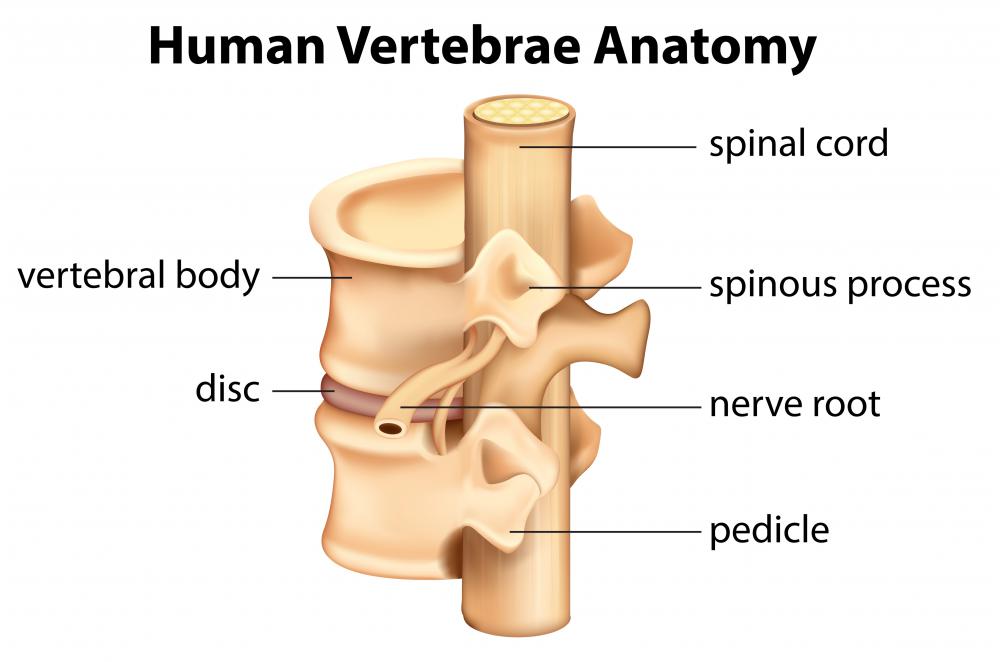At TheHealthBoard, we're committed to delivering accurate, trustworthy information. Our expert-authored content is rigorously fact-checked and sourced from credible authorities. Discover how we uphold the highest standards in providing you with reliable knowledge.
What is a Hemilaminectomy?
A hemilaminectomy is a surgical procedure, classically performed by a spinal surgeon, which is designed to relieve pressure on the nerves in the spine. This procedure is performed when patients have degenerative conditions leading to nerve damage or pain, causing discomfort and a loss of functionality for a patient. Because the procedure is invasive, it is usually only recommended when other treatment approaches have not worked and the surgeon feels that it is in the patient's best interest.
In the procedure, a surgeon removes the laminae, a part of the vertebrae, in an area of the spine. The procedure is known as a hemilaminectomy because the surgeon only removes the lamina from one side of a vertebra, rather than both, to maintain as much stability as possible. In a full laminectomy, the laminae from both sides are removed. Removing this structure creates more room for the nerve, relieving pressure and pinching.

Before the procedure can be performed, a neurological exam is conducted to determine which area of the spine is affected. The surgeon also typically orders medical imaging studies of the spine so that he or she can clearly visualize the area that requires surgery. The patient undergoes routine blood work to check for underlying medical problems that could complicate surgery, and meets with an anesthesiologist to discuss anesthesia options and prepare for the operation.

A hemilaminectomy is performed under general anesthesia, with the patient lying face down on a table designed for spinal surgery. As in other surgical procedures, the area is carefully cleaned and isolated with drapes. The length of the procedure can vary, since surgeons usually take their time, and they also order imaging studies during the operation to confirm their work, because they want to avoid making a mistake.

Pain after surgery is managed with the use of analgesic medications. The patient is usually hospitalized for several days so that he or she can be monitored for the signs of complications. Risks of the procedure can include infection at the wound site, kidney or bladder infections, nerve damage, spinal fluid leaks, or blood clots. Rarely, a patient may become paraplegic if the spinal cord is damaged. The risk of complications is greatly reduced by going to a skilled surgeon with a great deal of experience, and taking time during pre-surgery preparation to confirm that the surgeon has as much information as possible about the patient's medical history and condition.
AS FEATURED ON:
AS FEATURED ON:















Discussion Comments
@Candyquilt: Really? Remove the nerve? Wrong, wrong, wrong. I have been an OR nurse for 26 years with a most excellent and well noted spinal neurosurgeon! You cannot remove the nerve; that would cause paralysis! A microdiscectomy is the removal all or part of the damaged disc!
Years ago the incision was about 6" long. Micro means small! The incision is now 1-2"! I surely hope what you typed about removing the nerve was a huge mistake! Five weeks ago, I had an L4, L5 laminectomy and discectomy and facetectomy. Look it up! Anyway I am doing great and I am 65. That is more involved than a microdiscectomy but still my incision was only 2" long.
they do not remove the nerve -- that's impossible. They either remove the disc, what is called a discectomy, or they remove bone fragments to make more room for the nerve, which is called a laminectomy.
@ysmina-- Your doctor will give you some alternatives to surgery specific to your case. Physical therapy, medications for the pain, therapeutic treatments and exercise are among the most common. If you don't respond to these treatments, a surgery might be necessary. But, there really isn't much reason to worry! Lumbar surgery has advanced and is a reliable method. It will not only relieve the pain but will also prevent pressure or damage from occurring in the same area in the future.
What are some alternative treatments for a compressed nerve in the spine?
I have had longstanding lower back pain, and sometimes even numbness in my legs. I got an MRI, and the results will be back soon, but my doctor thinks that I have a compressed nerve in the lumbar part of my spine, and that I might have to have surgery. I really hate surgery though, so I was wondering if there were any other alternatives. Can anybody give me some more information?
I have worked for 17 years as an anesthesiology technician and assisted with many spinal disc surgeries, and I have to say, things have really changed in the spinal surgery world since I started. When I started, the success rate of hemilaminectomies was around 65%, but today, things are much better. This is because doctors now don't actually have to remove pieces of the vertebrae; instead they remove the nerve that is causing the problem. This procedure is called microdiscectomy and its success rate is over 90%.
Post your comments